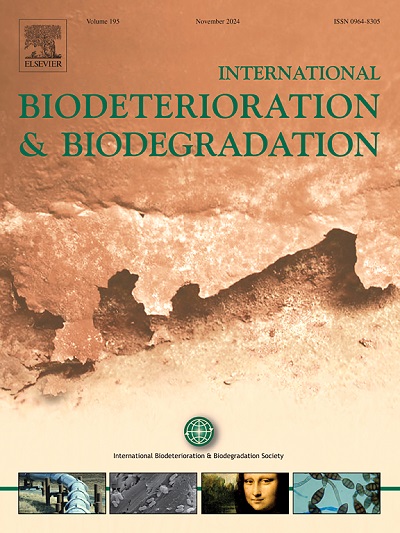Study on the dynamic changes of physicochemical properties, nitrogen functional genes, bacterial communities and their interactions during the composting of Chinese medicinal herbal residues
IF 4.1
2区 环境科学与生态学
Q2 BIOTECHNOLOGY & APPLIED MICROBIOLOGY
International Biodeterioration & Biodegradation
Pub Date : 2025-03-13
DOI:10.1016/j.ibiod.2025.106063
引用次数: 0
Abstract
Aerobic composting of Chinese medicinal herbal residues (CMHRs) constitutes an efficacious waste management strategy, yet optimizing nitrogen content remains challenging. The variations of physicochemical properties, nitrogen functional genes, and bacterial communities throughout the composting process, along with their interrelationships were explored in this study. The final compost product achieved maturity, with a C/N ratio of 10.96 and a nitrification index of 0.19. Quantitative PCR analysis indicated suboptimal nitrification efficiency due to insufficient activity of nitrifying microorganisms. 52 biomarkers at four stages of composting were identified by linear discriminant analysis effect size. Functional annotation of prokaryotic taxa exposed chemoheterotrophy (17.05%–25.52%) and aerobic chemoheterotrophy (11.84%–22.65%) as dominant bacterial functions. Canonical correspondence analysis discovered total nitrogen exerted the most significant impact on bacterial genus distribution. Bacteria affectting nitrification genes and nitration products, especially Anseongella and Weissella, were spotted through network analysis. The results revealed the important microbial groups facilitating the nitrogen conversion of compost of CMHRs, which provided a basis for optimizing nitrogen retention and improving the quality of compost.

中草药秸秆堆肥过程中理化性质、氮功能基因、细菌群落动态变化及其相互作用的研究
中药材秸秆好氧堆肥是一种有效的废弃物处理策略,但优化氮素含量仍具有挑战性。本研究探讨了堆肥过程中理化性质、氮功能基因和细菌群落的变化及其相互关系。最终堆肥产物成熟,C/N比值为10.96,硝化指数为0.19。定量PCR分析表明,由于硝化微生物活性不足,硝化效率不理想。通过线性判别分析,确定了堆肥4个阶段的52个生物标志物。原核生物分类群的功能注释显示,趋化异养(17.05% ~ 25.52%)和有氧趋化异养(11.84% ~ 22.65%)是细菌的优势功能。典型对应分析发现,总氮对细菌属分布的影响最为显著。通过网络分析,发现了影响硝化基因和硝化产物的细菌,特别是Anseongella和Weissella。结果揭示了促进CMHRs堆肥中氮转化的重要微生物群,为优化氮素滞留和提高堆肥质量提供了依据。
本文章由计算机程序翻译,如有差异,请以英文原文为准。
求助全文
约1分钟内获得全文
求助全文
来源期刊
CiteScore
9.60
自引率
10.40%
发文量
107
审稿时长
21 days
期刊介绍:
International Biodeterioration and Biodegradation publishes original research papers and reviews on the biological causes of deterioration or degradation.

 求助内容:
求助内容: 应助结果提醒方式:
应助结果提醒方式:


